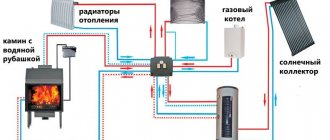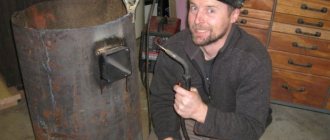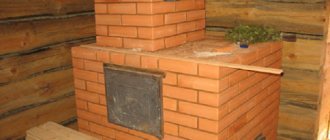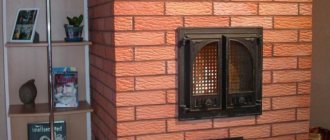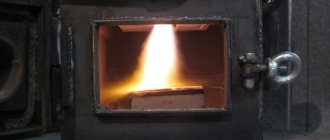Speaking about the art of designing and building brick stoves, one cannot help but recall one of the most talented Russian stove masters of our time - I.V. Kuznetsov. His name is on a par with such famous stove developers of the past as V.E. Grum-Grzhimailo and I.S. Podgorodnikov. Igor Vladimirovich has over one and a half hundred developments brought to life, and Kuznetsov’s bell-type furnaces have gained wide popularity both in the post-Soviet space and abroad. In this article we will try to figure out what the secret of the success of these developments is, and also consider the types of Kuznetsov furnaces.
Features of the Kuznetsov furnace
Since the main goal of Kuznetsov’s developments was efficiency and productivity (he worked to increase the efficiency value), this required a fundamentally new and improved approach.
If you look at the drawings of Kuznetsov’s furnaces, every professional sees that he has thought out the system of internal gas movement most competently. As a result, thanks to the design solution, hot air lingers in the unit for a longer time and retains heat, and cooled air masses quickly fly away into the chimney through a special recess.
Such furnaces are called “bell-shaped” furnaces. Inside, they combine the hearth and the lower part, creating a kind of cap. Its functional purpose is to separate gases into cold and hot. The last of them rise into the bell and, lingering in it, concentrate the heat. The combustion temperature in such units is higher, and their efficiency is 95%. How much more efficient the functioning of the structures developed by Kuznetsov is is evidenced by the fact that for a traditional Russian stove this figure is 25-40%.
Design and principle of operation
The expression “Everything ingenious is simple!” fully concerns the design of the dome furnace, which allows you to realize the advantages of the free movement of gases. The simplest two-bell unit, shown in the figure on the left, works as follows. The air necessary for burning firewood enters through the ash pan 1. The firebox 2 is made in the form of a tapering nozzle, thanks to which it is possible not to allow outside air to pass through excessively. Otherwise, it will immediately go into the second bell, carrying heated gases with it. The so-called gas view, which forms under the dome, also prevents the entry of heavy cold air. By the way, due to the simple design, the atmosphere established inside the furnace is often unstable - it is disrupted by the draft from the outer hood. That is why two-bell stoves, known long before Kuznetsov’s birth, were not popular.
Operating principle of a two-bell furnace
During active combustion of wood, flammable gases that have not had time to be oxidized by atmospheric oxygen rise under the dome 4 of the inner bell 3. There they ignite under the influence of an open flame and high temperature. We can say that a zone appears under the hood, similar to the one that forms in the afterburning chamber of a conventional pyrolysis furnace. It is also important that the process of pyrolytic combustion regulates itself - with a very intense flame, the outflow of combustion products becomes difficult, and, accordingly, the draft decreases. If the pyrolysis gases burn out, the process is restored. At the same time, no less important processes occur under the arch of the second hood. In this zone, nitrogen oxides and carbon monoxides (carbon monoxide) react, which, as a result of reactions, decompose into harmless components. When the dome unit operates correctly, predominantly water vapor and carbon dioxide escape into the chimney.
When wood burning comes to an end, the hoods act as storage tanks, holding heated air masses under their arches. Unlike channel furnaces, where the residual combustion products simply “fly out into the chimney,” in “smiths” they give up all their energy to the brick walls.
The ideal option for a two-bell furnace would be a round-shaped unit. In this case, the body of the heating device could serve as an upper dome. Unfortunately, in practice, it is difficult to build such a heat generator not so much because of its spherical shape, but because of the difficulties in arranging cleanouts and hatches for their maintenance. Because of this, the hoods are connected to each other by a wide channel that runs in the back of the oven. This feature is reflected in the diagram on the right.
If it is necessary to integrate a water heating circuit into the furnace, it is installed under the arch of the second hood. This method does not affect the thermal equilibrium of the system and does not have a negative impact on the fuel combustion mode.
The efficiency of furnaces of this type can be further increased by installing several cascades, each of which consists of two hoods, however, due to the complexity of installation and increased requirements for the heat resistance of the lining, such designs are not popular among amateur stove makers.
Basic rules for creating a heating stove
- To make Kuznetsov stoves, the ordering (masonry diagrams) should be printed in advance.
- The refractory shell located inside the furnace must be free on all sides, since the brick expands during the heating process.
- Internal refractory masonry when using fireclay bricks is always done on edge. If the bricks are made of clay, on the inner walls and on the posts, they are laid at the discretion of the stove-maker.
- To strengthen the bond, a wire is laid every two brick rows.
- When a Kuznetsov stove is created, the ordering of brick stoves for a home provides that various elements (for example, doors) are installed in such a way that there is room for expansion. A special gasket is placed between the brick and the metal element.
- After completing the construction of a brick structure, it should be treated with a fire-resistant compound.
- The first kindling begins at a minimum temperature and is then gradually increased.
Ordering the Kuznetsov furnace
Laying out the heating structure yourself is a completely solvable task, but it will require ordering a Kuznetsov sauna stove or another type of heating unit. The operating principle of the heating device is not so complicated that it is impossible to understand.
To create a high-quality heating unit, regardless of the bell-type version or the Kuznetsov stove for a bath, ordering will be required, as will a general drawing. What is order? This is a set of drawings that schematically depict the step-by-step construction of a stove with your own hands, in detail for each row of bricks. No changes should be made to them.
Advantages and disadvantages of “Kuznetsovka”
Bell furnaces differ from other types of furnaces in a large number of advantages:
Bell furnace
- The main advantage of bell-type furnaces is their high efficiency. About 80-85%. This is much higher than other types of ovens.
- Fuel combustion occurs at very high temperatures, without third-party technologies.
- Any fuel is suitable for bell-type furnaces. During combustion, an extremely small amount of soot remains.
- Due to minimal soot formation, these ovens do not require constant cleaning.
- Possibility of combining a bell-type stove and water heating at home. At the same time, the technical characteristics of the furnace do not change.
- Short chimney. Thanks to this type of design, there are savings on building materials. However, the traction force does not decrease.
- This stove is suitable for any room, regardless of the size of the room and its purpose.
- The design of “Kuznetsovka” can be customized to suit many customer ideas.
- In bell-type furnaces, there is no need to actively use a viewer. The air is self-distributed.
- Durability. Thanks to uniform heating and cooling, the oven is less susceptible to deformation.
- Easy to assemble. Even a person without experience, following the necessary instructions, can assemble Kuznetsov stoves. However, this is not always the case.
The disadvantages of such furnaces are much less than the advantages. The disadvantages include:
- The need for the help of a master in the construction of several domes. Such services cost money.
- Massive size. However, standard Russian stoves are not small in size.
- It is not always possible to obtain 80% efficiency from a bell-type furnace. Typically this figure is 55-60%.
A correctly selected type of bell-type stove can provide not only heating for living spaces, but also help with cooking food or heating water
Rating (No ratings yet) Did you like the article? Share with friends:You may also be interested in How to choose the right gas burner for a sauna stove? A burner for a sauna stove allows you to convert, at minimal cost, an existing wood-burning heating boiler into a mesh stove for a sauna: how to build it yourself? Stones in a steam room, laid in a wire mesh, significantly increase steam output and overall efficiency Paint for stoves and fireplaces: types of materials In order for the heating devices in the house to fit well into the overall design, they are coated with special coatings. We understand how to properly chop wood. Every homeowner has to chop wood. , if he chooses wood for kindling. Let's look at how to professionally make homemade sawdust briquettes. Sawdust briquettes are very popular in Europe because of their environmental friendliness and availability. How to light wet wood? Damp firewood is quite suitable for kindling if done correctly. However, heating the stove with damp
Add a comment Cancel reply
Name *
Email *
A comment
Search:
- Contacts
- Site Map
textarea>textarea>header>header>header>header>header>header>
Materials for building a brick kiln
- Fireclay brick
for interior masonry. You can calculate its quantity according to the order. For a simple design you will need a little of it. - Clay bricks
for external masonry, when created, including Kuznetsov bell furnaces - the order will help you find out its quantity. It is advisable to purchase products of the M150 brand. - Clay
in the amount of 100-150 kilograms. It must be of good quality. Otherwise, during the first firing of the finished structure, the solution will crack. - Cleaned sand
. It will require 2 times more than clay. Ready-made clay-sand mixtures are available for sale. They are needed for 500 bricks, approximately 0.2 m³. - Metal fittings
- grate, combustion and blower doors, 2 steel angles, 5 meters of wire.
Order samples
This article discusses the Kuznetsov bell-type furnace, and more specifically, one of its variants. Each row should be laid out in a numbered order in full accordance with the images. This oven has a simple design and is a universal solution for household use.
Similarly, when there is an order on the Kuznetsov stove for a bathhouse, you can do the laying yourself (read also: “Ordering a stove for a bathhouse with your own hands”). After the work on creating a heating unit is completed for the first time, it becomes clear to every performer that this is not difficult and quite doable.
Next time we will be able to make a more complex design without any problems. It could even be a two-bell Kuznetsov stove - the order of one of the creation options of which is available as an example on the website. Perhaps in the future there will be a desire to bring into reality one of the many projects of the great master. Video of the phased construction of the Kuznetsov furnace according to the drawings:
Varieties for different purposes
Igor Kuznetsov and his team have created a large number of universal and specialized models. Some are intended only for heating rooms, others are supplemented with elements for cooking or heating water. Fireplaces are a separate area.
Drawings of options tested in practice are collected on the inventor's website. For convenience, the structures are assigned alphanumeric designations.
Heating
Kuznetsov's heating stove for a two-story house allows you to save on fuel.
Various dome layout options make it possible to construct designs for heating one- and two-story houses.
Heating models are abbreviated as OIK (heating models by I. Kuznetsov). You can find options with a firebox located inside the room or in the utility room.
For variety and to give the desired qualities, there are stoves supplemented with warm beds (OIK -6 bed. AND OIK 19 bed.) and seats (OIK-7s).
Some products have built-in ovens. In this case, the letter D is added to the code designation, for example, OIK-5D.
Heating stoves also include stoves with a built-in fireplace.
Models RTIC (Russian heated heater by I. Kuznetsov) are needed for heating large rooms. They are massive and need a strong foundation.
Options with fireplace
Model with a fireplace
Fireplaces, in addition to their heating function, serve as interior decoration. In this case, the firebox is open, the fire can be observed visually. The stoves are equipped with a firebox for conventional heating, which can be located on the facade, on the right, left side, or behind.
For construction, they choose an option in which it is convenient to service the stove from a utility room or hallway - you do not have to carry firewood into the living room. Working with waste (ash) also does not imply inevitable dirt in the room when cleaning the ash pan and the vent from the hallway.
Options for OIK-K have been developed with couches, built-in ovens and a corner fireplace.
Boilers
To organize a water heating circuit, options have been developed with the designation KIK (I. Kuznetsov boiler). A steel heat exchanger is built into the second dome. Water circulates through the system due to an electric pump.
Models are designed for power of 16, 17, 34 and 64 kW. The first option (16 kW) is equipped with a hob.
Heating and cooking
A heating and cooking model is a structure that completely exhausts the fuel resource.
Universal heating and cooking stoves are designed for homes with year-round occupancy. The model has built-in hobs and ovens, shelves for heating food and water.
The firebox can be located on the front or side, which allows you to choose an option for any interior design.
Installation of a bed is available as an option. For large rooms, elongated fireboxes are made, which allows the use of large-caliber firewood. They burn longer and you will have to add fuel less often.
The size of the hob depends on the composition of the family. For 2–3 people, choose a reduced surface, which saves fuel.
For the bath
I. Kuznetsov singled out sauna stoves as a separate area. There are three varieties: BIC, BIC BC and BIC PC. The abbreviation BIC corresponds to the purpose, and additional symbols indicate that the structure is equipped with a fireplace.
For different layouts, models are chosen that differ in the location of the firebox and fireplace - in the steam room, relaxation room or in the dressing room.
